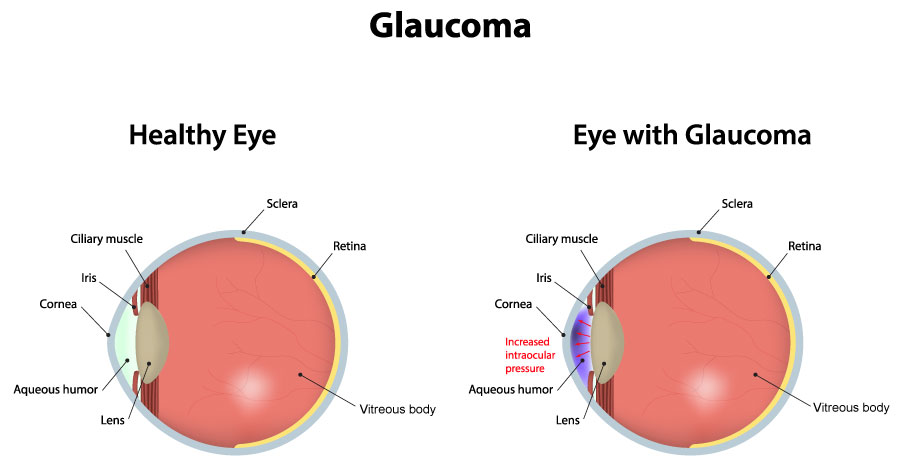What is glaucoma?
Glaucoma is a group of eye diseases that cause damage to the optic nerve. The optic nerve is an essential part of the eye that carries information from the retina to the brain so you can see. When the nerve is damaged, vision can be compromised. Vision loss as a result of glaucoma can never be restored — early detection and treatment of glaucoma are crucial to prevent serious vision loss.
What causes glaucoma?
Aqueous, a watery fluid present in the interior of the eye, helps maintain a healthy eye by continuously flowing in and out of the eye. The fluid moves through the drainage angle, which contains a mesh-like layer of tissue over the iris. When this flow is blocked, by the angle or otherwise, the fluid can build up and cause eye pressure levels to increase. High eye pressure can damage the optic nerve and cause irreversible vision loss.
Who is at risk for glaucoma?
Generally speaking, anyone age 60 and up is considered to be at high risk for glaucoma. Other factors that can heighten your risk include:
- Diabetes
- African American or Hispanic ethnicity
- Nearsightedness
- Thin corneas
- Hypertension
- Family history of glaucoma
For individuals who are at high risk, it is beneficial to schedule regular eye exams even before age 60. Early detection and treatment of glaucoma can significantly reduce the chance of experiencing severe vision problems.
What are the different types of glaucoma?
- Open-angle glaucoma is the most common type of glaucoma. It’s called “Open-Angle” because the drainage angle is open and unobstructed, but the aqueous flow still does not drain properly. This type of glaucoma is often a result of age, as the drainage angle doesn’t work as well over time. Younger people can also develop this form of glaucoma.
- Closed-angle glaucoma is not as common as OAG and is harder to detect in the early stages. It happens when the angle gets closed off by the iris getting too close to the cornea, which lies just above the angle. This can be likened to a piece of paper sliding over a sink drain. The fluid and pressure build up is often immediate and indicated by acute pain. Emergency treatment is crucial to preserve a patient’s vision..
What are commons signs and symptoms of glaucoma?
Unfortunately, many symptoms are not present during the early stages of glaucoma. Often, the primary symptom of open-angle glaucoma is when your peripheral vision starts to fade. At this point, vision loss cannot be restored. This is why it’s important to have regular eye exams to catch the disease early, before any damage has been done to the optic nerve.
Closed-angle glaucoma is characterized by symptoms such as severe eye pain, headache, nausea, blurry vision, and red eyes. If you experience these symptoms, see an eye specialist or go to the emergency room immediately.
How is glaucoma treated?
There is no cure for glaucoma, but there are ways to treat and manage the disease to prevent visual loss. These treatments vary and may be recommended to different patients based on the severity of the disease.
- Eye Drops: Eye drops work to lower intraocular pressure (IOP) in glaucoma patients. The drops need to be used regularly to maintain a low IOP and may have some side effects.
- Drainage Implants: Often called shunts or stents, these implants can be surgically placed in the eye to promote drainage. The implant is placed so the aqueous can drain regardless of whatever may be clogging up the flow. There are a lot of different kinds of implants, so be sure to ask your doctor about what they have available and what kind is best for you.
- Trabeculectomy: A trabeculectomy is a surgery that creates a drainage channel between the two outer layers of the eye. This procedure can be done by either removing tissue or making incisions.
- Laser Treatment: There are several kinds of laser surgeries that can treat glaucoma. For example, Selective Laser Trabeculectomy (SLT) can be used in place of a regular trabeculectomy, where incisions can be made more precisely with a laser rather than a blade. Other forms of laser surgery include an iridotomy, which involves making a small hole in the iris with a laser to treat or prevent angle closure.
Glaucoma Treatment, Melbourne, FL
The goal of glaucoma treatment is to prevent loss of vision. How your glaucoma is treated depends on the specific type of glaucoma, how far the disease has progressed, and how well it responds to treatment. Contact us today to discuss your options for glaucoma treatment in Melbourne, FL.




